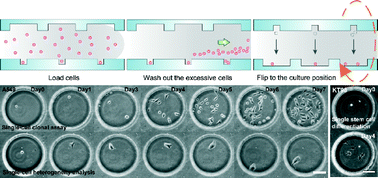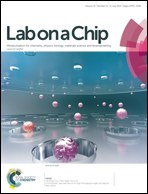A microfluidic dual-well device for high-throughput single-cell capture and culture†
Abstract
In vitro culture of single cells facilitates biological studies by deconvoluting complications from cell population heterogeneity. However, there is still a lack of simple yet high-throughput methods to perform single cell culture experiments. In this paper, we report the development and application of a microfluidic device with a dual-well (DW) design concept for high-yield single-cell loading (~77%) in large microwells (285 and 485 μm in diameter) which allowed for cell spreading, proliferation and differentiation. The increased single-cell loading yield is achieved by using sets of small microwells termed “capture-wells” and big microwells termed “culture-wells” according to their utilities for single-cell capture and culture, respectively. This novel device architecture allows the size of the “culture” microwells to be flexibly adjusted without affecting the single-cell loading efficiency making it useful for cell culture applications as demonstrated by our experiments of KT98 mouse neural stem cell differentiation, A549 and MDA-MB-435 cancer cell proliferation, and single-cell colony formation assay with A549 cells in this paper.


 Please wait while we load your content...
Please wait while we load your content...